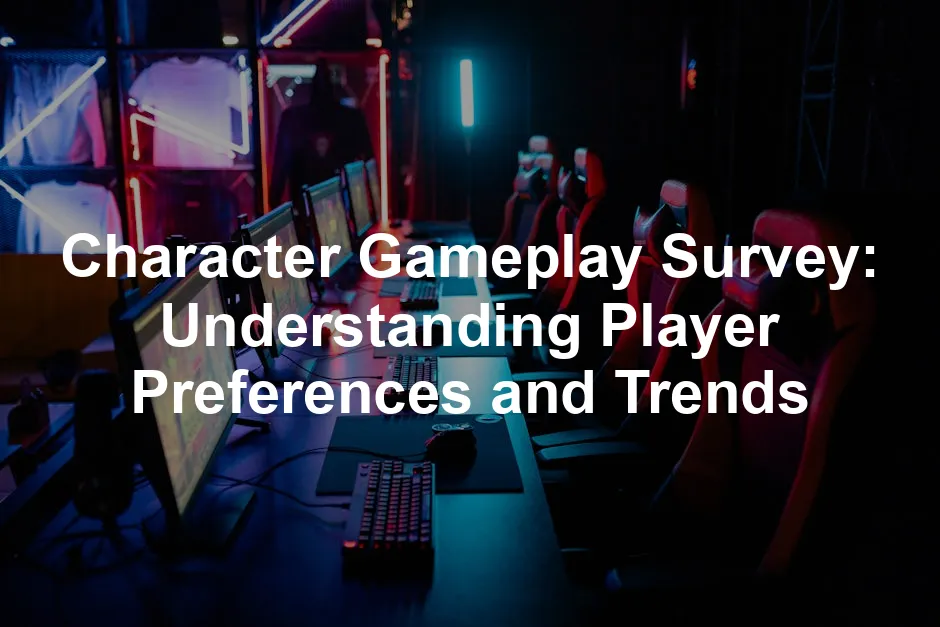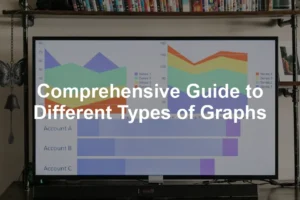Introduction
Have you ever wondered how player preferences shape video games? Character gameplay surveys play a vital role in the gaming industry. These surveys gather player feedback, which is crucial for guiding game design and character development. As players share their thoughts, developers gain valuable insights on what resonates with gamers. This article aims to explore the purpose, methodologies, and key findings of character gameplay surveys.
Speaking of gaming, if you’re looking to dive into an immersive experience, consider getting a Nintendo Switch Console. With its versatility, you can play at home or on the go, making it perfect for any gamer on the move!

Summary and Overview
Character gameplay surveys are comprehensive tools that collect player opinions on various aspects of gaming. They provide insights into player interactions and preferences, ultimately enhancing the gaming experience. By analyzing survey results, developers can identify trends in character design and gameplay mechanics.
One notable trend is the growing demand for diverse characters. Players increasingly seek representation in character backgrounds and abilities. This shift highlights the importance of inclusivity in gaming. Survey findings can significantly impact future game development and player engagement, ensuring that games evolve alongside player expectations.
In summary, character gameplay surveys are essential for understanding player preferences. The insights gained from these surveys help shape a more engaging and representative gaming landscape. As the industry continues to adapt, player feedback will remain a cornerstone of game design and character development.

Importance of Character Gameplay Surveys
Understanding Player Preferences
Character gameplay surveys are essential tools for identifying player preferences. They provide insight into the types of characters gamers enjoy. For instance, many players favor heroic and relatable character types. This insight helps developers create characters that resonate with players.
Moreover, surveys reveal preferences for character abilities and gameplay styles. Some players enjoy powerful combat skills, while others prefer support roles. This variety indicates the need for diverse character options in games.
Diversity and representation in character design are increasingly significant. Gamers want to see characters that reflect a wide range of backgrounds. Recent surveys show that 61% of players prioritize inclusivity in gaming. This trend highlights the importance of creating characters that appeal to a broader audience.
Speaking of diverse characters, if you’re a fan of role-playing games, check out Dungeons & Dragons: Player’s Handbook. It’s the perfect guide to creating your own unique character and embarking on epic adventures!

Enhancing Game Development
Survey data greatly influences game design decisions. This feedback creates a valuable feedback loop between players and developers. By understanding player desires, developers can tailor their games to meet these needs.
Many games have successfully integrated survey feedback into their development processes. For example, a popular RPG revamped its character roster after survey analysis revealed player dissatisfaction. This change not only improved player engagement but also boosted overall game satisfaction.
Community engagement plays a crucial role in shaping game updates. Regular surveys allow developers to stay in touch with player interests. A recent survey showed that 68% of players felt more connected to games that actively sought their opinions. This engagement fosters a sense of ownership and loyalty among players, enhancing their gaming experience.
If you’re looking to enhance your gaming setup, consider grabbing a Razer DeathAdder V2 Gaming Mouse. Its ergonomic design ensures comfort during those long gaming sessions!

Surveys also reveal specific areas for improvement. For instance, a recent analysis indicated that 52% of players wanted more customization options for their characters. Addressing these requests can lead to better player retention and satisfaction. By listening to player feedback, developers can create a more engaging gaming environment tailored to their audience’s needs.
Types of Character Gameplay Surveys
In-Game Surveys
In-game surveys offer immediate insights into player experiences. These surveys typically pop up during gameplay, allowing players to share their thoughts in real-time. This method captures feedback on character interactions and gameplay mechanics effectively.
For instance, popular games like Genshin Impact utilize this technique. Players can provide feedback right after engaging with new characters or features. This approach allows developers to gather valuable data while the experience is still fresh in players’ minds.

Research suggests that participation rates in in-game surveys can exceed 50%. This high engagement level indicates players are willing to share their thoughts when prompted at the right moment. In-game surveys not only enhance player experience but also empower developers to make informed decisions.
Online Surveys
Online surveys extend the reach of character feedback beyond the game. They allow developers to gather data from a more diverse audience. Players can share their opinions at their convenience, leading to broader demographic insights.
Comparing in-game to online surveys reveals interesting differences. In-game surveys often yield immediate feedback, while online surveys can collect detailed responses over time. Platforms like Discord and gaming forums are popular for distributing these surveys, facilitating community engagement.
Response rates for online surveys can vary, but engaging designs often lead to higher participation. For instance, surveys that offer incentives, like in-game rewards, can increase engagement levels significantly. This method captures a wider range of player experiences and preferences, benefiting game design.

Focus Groups
Focus groups provide a unique opportunity for gathering qualitative feedback. These sessions involve small groups of players discussing their gaming experiences in-depth. This format encourages players to express their thoughts freely, leading to richer insights.
Typically, focus groups consist of diverse participants, ensuring varied perspectives. During these discussions, developers can ask open-ended questions, allowing for deep dives into specific topics. The benefits of such discussions are invaluable, as they uncover player motivations and preferences.
Insights gained from focus groups can lead to significant design changes. For example, a game development team might discover that players want more character customization options. Statistics indicate that focus group feedback can influence up to 60% of design decisions in some cases. This method fosters a strong connection between developers and players, further enhancing the gaming experience.

Key Findings from Recent Character Gameplay Surveys
Trends in Character Design
Recent surveys reveal exciting trends in character design. Players increasingly favor popular archetypes like heroes and anti-heroes. This shift reflects a desire for characters that resonate with personal values.
Player expectations about character evolution have also changed. Many desire characters that grow and adapt throughout the game. This evolution enhances player engagement and investment in character storylines.
Diversity in character backgrounds is a growing demand. Players want to see a wide range of cultures, races, and identities represented. A survey showed that 75% of respondents appreciate characters that challenge traditional norms. This push for inclusivity signals a robust shift in gaming culture.
Statistics indicate that 68% of players prioritize unique character designs over generic options. This preference highlights the importance of creativity in character development. By catering to these trends, developers can create more engaging gaming experiences.

Gameplay Mechanics Preferences
Players express strong preferences regarding gameplay mechanics tied to characters. Many gamers desire specific abilities and skills. Combat styles, support roles, and unique powers top the list of desired features.
Furthermore, customization options are crucial for player satisfaction. Players want to tailor their characters to reflect their personal play styles. A survey showed that 62% of players feel more invested in games offering extensive customization systems.
Progression systems also play a vital role in character satisfaction. Players appreciate mechanics that reward skill improvement and character growth. Data reveals that 70% of gamers find satisfaction in games that offer meaningful progression.
Overall, the integration of these mechanics significantly impacts player enjoyment. Developers should prioritize player preferences to enhance character gameplay experiences.

Impact of Stereotypes and Representation
Player perceptions of stereotypes influence character engagement. Many gamers emphasize the importance of representation in character selection. They want characters that reflect diverse perspectives and backgrounds.
Players actively seek characters that challenge traditional stereotypes. A significant 65% of respondents reported wanting more complex, multifaceted characters. This desire for depth indicates a shift away from one-dimensional portrayals.
Successful examples include games that have diversified their character rosters. Titles like The Last of Us Part II and Overwatch showcase characters with rich backgrounds and unique identities. These games have proven that diverse representation resonates well with audiences.
Surveys reveal that 72% of players feel more connected to games featuring diverse characters. This connection fosters a deeper engagement and enhances overall gaming experiences. By prioritizing representation, developers can create more inclusive and relatable gaming worlds.

Best Practices for Conducting Character Gameplay Surveys
Designing Effective Surveys
Creating impactful surveys is essential for gathering valuable insights. Start by balancing quantitative and qualitative questions. Quantitative questions offer numerical data, while qualitative questions provide depth and context. Both types together capture a fuller picture of player opinions.
Clarity and conciseness in questions matter significantly. Avoid jargon and ensure each question is easy to understand. This approach helps players provide accurate responses without confusion. For example, instead of asking, “Rate your satisfaction with character diversity,” consider “How satisfied are you with the variety of characters?”
Engaging players can boost response rates. Use incentives like in-game rewards to encourage participation. Additionally, keep surveys short to respect players’ time. A well-structured question might be, “What character traits do you find most appealing?” This invites thoughtful responses without overwhelming the player.

Analyzing Survey Data
Once you gather survey data, it’s time to analyze and interpret it. Start by identifying patterns and trends in player responses. Look for common themes that emerge across different demographics. This process can reveal what players truly want and expect from characters.
Segmenting data based on demographics is crucial. For instance, analyze responses by age, gender, or gaming experience. This segmentation helps tailor future game developments to specific player groups. Tools like Google Analytics and Excel can aid in visualizing data trends effectively.
Using insights from the surveys is vital for informing game development. Share findings with your development team to guide character design and gameplay mechanics. For example, if a significant number of players express a desire for more diverse character backgrounds, prioritize that in upcoming updates. Understanding these insights can also help in overcoming challenges in parametric statistics assumptions in survey data analysis.

Understanding survey data analysis is crucial for developers. Overcoming challenges in parametric statistics assumptions in survey data analysis can provide valuable insights into player feedback.
Conclusion
Effective character gameplay surveys can significantly enhance game design and player engagement. By focusing on clear, engaging questions and thorough data analysis, developers can gain invaluable insights. This process ensures that players feel heard and that their preferences shape future character designs. Engaging in these surveys not only influences game development but also fosters a sense of community among players. Make your voice heard and participate in surveys to help shape the games you love!
And while you’re at it, if you’re a console gamer, consider upgrading your system with the PlayStation 5 Console for an unmatched gaming experience!
Please let us know what you think about our content by leaving a comment down below!
Thank you for reading till here 🙂
All images from Pexels




